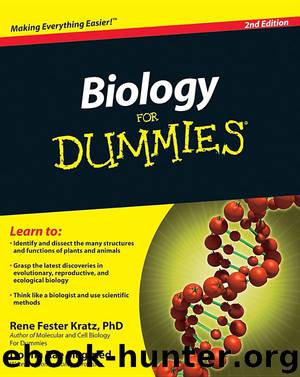Biology For Dummies, 2nd Edition by Rene Fester Kratz PhD & Donna Rae Siegfried

Author:Rene Fester Kratz, PhD & Donna Rae Siegfried
Language: eng
Format: epub
Publisher: Wiley Publishing
Published: 2010-05-11T16:00:00+00:00
Following along in Figure 11-8, you see that energy travels to the Earth from the Sun. About 1 percent of the energy available to producers is captured and stored in food. Producers grow, transferring much of their stored energy into ATP for cellular work (as explained in Chapter 5) and the molecules that make up their bodies. As producers transfer energy for growth, some energy is also transformed into heat that’s transferred to the environment.
About 10 percent of the energy that was originally stored in producers is transferred to primary consumers when they eat the producers. Just like producers, the primary consumers grow, transferring energy from food into ATP for cellular work and into the molecules that make up their bodies. As primary consumers transfer energy for growth, some energy is also transformed into heat that’s transferred to the environment. This process repeats itself when secondary consumers eat primary consumers and when tertiary consumers eat secondary consumers. Each level of consumer receives about 10 percent of the energy originally captured by the organism it consumed, and as the consumer uses energy for growth, it transfers some of that energy back to the environment as heat.
But the energy pyramid doesn’t end there. As organisms die, some of their remains become part of the environment. Decomposers and detritivores use this dead matter as their source of food, transferring energy from food into ATP and molecules and giving off some energy as heat.
Note: Food chains and energy pyramids usually don’t go beyond tertiary consumers because the amount of energy available to each level is reduced as you move up the pyramid. Past the tertiary consumer level, too much energy has been depleted from the system.
Cycling matter through ecosystems
Not only does food provide energy to living things (as explained earlier in this chapter) but it also provides the matter organisms need to grow, repair themselves, and reproduce. For example, you eat food that contains proteins, carbohydrates, and fats, and your body is made of proteins, carbohydrates, and fats (see Chapter 3 for more on these molecules). When you eat food, you break it down through digestion (covered in Chapter 16) and then transfer small food molecules around your body via circulation (covered in Chapter 15) so that all of your cells receive food. Your cells then have two options:
They can use the food for energy by breaking it down into carbon dioxide and water through cellular respiration (see Chapter 5).
They can rebuild the small food molecules into the larger food molecules that make up your body.
Yes, that second option means you are what you eat — well, almost. You don’t use food molecules directly to build your cells; you break them down first and use the pieces to build what you need. In other words, your cells are made of human molecules that are rebuilt from the parts of molecules taken from the plants and animals you’ve eaten. So really you’re made of molecules that you recycled from your food. (Likewise, the living things your food used to be got their molecules by recycling them from somewhere else.
Download
This site does not store any files on its server. We only index and link to content provided by other sites. Please contact the content providers to delete copyright contents if any and email us, we'll remove relevant links or contents immediately.
What's Done in Darkness by Kayla Perrin(26768)
The Ultimate Python Exercise Book: 700 Practical Exercises for Beginners with Quiz Questions by Copy(20538)
De Souza H. Master the Age of Artificial Intelligences. The Basic Guide...2024 by Unknown(20348)
D:\Jan\FTP\HOL\Work\Alien Breed - Tower Assault CD32 Alien Breed II - The Horror Continues Manual 1.jpg by PDFCreator(20327)
The Fifty Shades Trilogy & Grey by E L James(19235)
Shot Through the Heart: DI Grace Fisher 2 by Isabelle Grey(19221)
Shot Through the Heart by Mercy Celeste(19081)
Wolf & Parchment: New Theory Spice & Wolf, Vol. 10 by Isuna Hasekura and Jyuu Ayakura(17260)
Python GUI Applications using PyQt5 : The hands-on guide to build apps with Python by Verdugo Leire(17203)
Peren F. Statistics for Business and Economics...Essential Formulas 3ed 2025 by Unknown(17045)
Wolf & Parchment: New Theory Spice & Wolf, Vol. 03 by Isuna Hasekura and Jyuu Ayakura & Jyuu Ayakura(16963)
Wolf & Parchment: New Theory Spice & Wolf, Vol. 01 by Isuna Hasekura and Jyuu Ayakura & Jyuu Ayakura(16592)
The Subtle Art of Not Giving a F*ck by Mark Manson(14555)
The 3rd Cycle of the Betrayed Series Collection: Extremely Controversial Historical Thrillers (Betrayed Series Boxed set) by McCray Carolyn(14284)
Stepbrother Stories 2 - 21 Taboo Story Collection (Brother Sister Stepbrother Stepsister Taboo Pseudo Incest Family Virgin Creampie Pregnant Forced Pregnancy Breeding) by Roxi Harding(13932)
Scorched Earth by Nick Kyme(12923)
Drei Generationen auf dem Jakobsweg by Stein Pia(11118)
Suna by Ziefle Pia(11042)
Scythe by Neal Shusterman(10508)
